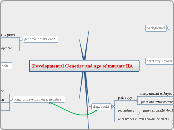Developmental Genetics and age of mutants IIA
background
genes
thought came from cytoplasm
these cytoplasmic factors could control cell fate
tought variations were too subtle
political
two demands
needed to show could control earliest most basic phases of development
how chromosomes indential in every cell type can produce cytoplasm with different properties
early steps towards developmental genetics
mouse mutation Brachyury
heterozygoud mice - short tail
homozygous - die before birth
brachyury mutants aka T have defects in posterior part early embryo
disruption of notochord
fly mutations affect wing development
genomic equivalence
experiments to prove
regeneration experiments
loss of limbs of salamanders
cloning of somatic nuclei
albino parents of nucleus donor to wild type donor of enucleated eggs
are all albino
genes act in both early and late stages of development
showed genes are regulated differently in different cell types during devlopment
still question of nature vs nurture
developmental genetics in Drosophila
characterized homeotic genes that act later in development
maternal acting genes that control earliest stage sof development
logic of developmental genetics
A) loss of function reveals normal functionc
reverse genetics and knockouts
requires no previous information
enough genetic info, specific gene disrupted can be indetified and studied molecularly
drawbacks
pleiotropy
many mutant embryos die
genes are invovled many tissues, hard to implicate one
redundancy
genes in parallel don't show phenotype until entire set knocked out
only works in few animals or plants
need sort generation time and easy lab culture
zygotic vs maternal effect phenotypes
based on mom, must be homozygote dominant mutant for offspring to express trait
